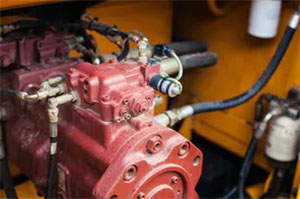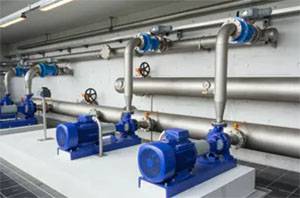One of the main causes of hydraulic failure is contamination in the hydraulic system. Some estimates believe that 75% of the failure can be traced to contaminated or aging hydraulic oil, while others believe that 80% of the cause is simply pollution. However, you can minimize the penetration of pollutants into the system. You can implement preventive steps in your existing hydraulic system preventive maintenance plan to minimize the impact of air and water, as well as steps you can take to mitigate existing damage.
1. hydraulic oil pollution problems:

Hydraulic oil contamination refers to foreign matter entering the system. This type of contamination can paralyze your equipment, premature damage and excessive wear of one part after another, which can lead to cascading failures and catastrophic failure of the system itself. Pollution cannot be eliminated, but it can be mitigated.
Water and particulate matter are the most common forms of hydraulic pollution. Both can cause major problems for hydraulic systems and are usually invisible to the naked eye.
1) Water pollution
Water pollution will not only damage the performance of hydraulic oil, but also cause corrosion and cavitation problems. If there is enough water in the system, the water in the fluid will freeze and lock the valve. Water contamination also reduces the ability of the hydraulic oil to provide lubrication, increases the noise level of the equipment, causes accelerated wear of key components, increases the acidity of the hydraulic oil, and reduces the effectiveness of additives (even causing unnecessary chemical reactions). If enough water enters the hydraulic oil, a cloudy appearance may begin to appear. This occurs when the fluid is saturated with water.
2) Particulate contamination
Particulate contaminants consist of particles entering the system, most of which are so fine that their diameter is smaller than that of a human hair. When the system is running, certain particles are generated from the inside of the system, so it cannot be avoided. Other forms of particulate matter may also be present when assembling systems or manufacturing components. This inherent contamination can include sand particles left over from the casting process, metal fragments left over from the processing process, or even fine rags used to wipe things.
Any time dust is opened for maintenance or repair, dust and debris will enter the system and will be introduced when hydraulic oil is added. Even clean hydraulic oil may contain particulate matter, which may exceed the recommended limits for newer hydraulic equipment.
2. hydraulic fluid contamination test:

The most effective way to test for contamination is to perform a hydraulic oil analysis, also known as a fluid test. Fluid testing can measure levels of contamination that are invisible to the naked eye, but can still wreak havoc on hydraulic systems. Chemical fluid testing in the laboratory includes not only the measurement of solid contamination, but also the decomposition of water, additives, and any chemical reactions that may occur in the fluid.
Samples of hydraulic oil are collected at various points in the hydraulic system and sent to the laboratory for detailed chemical analysis or, if tested on site, run through a particle counter. Then prepare a report detailing all the contaminants found in the fluid. Such a report not only provides information on the level and severity of pollution, but also provides insights into where pollution may occur if multiple samples are taken.
3. repair repair:

Corrective maintenance is the opposite of preventive maintenance of hydraulic systems. Corrective maintenance can address contamination issues, for example, maintenance or repair after fluid analysis to address contamination issues. One corrective action is to drain the existing hydraulic oil and replace it with fresh hydraulic oil. The replacement of hydraulic oil can be scheduled regularly; however, hydraulic oil and downtime are costly, so many experts recommend doing this only if a large amount of contamination is found.
Severe contamination situations, such as contamination that occurs after a catastrophic failure of a major component (e. g., a hydraulic motor or pump), may release abrasive metal particles into the system. This highly contaminated condition requires flushing of the hydraulic system, which requires the following:
1) Drain all the hydraulic oil in the system;
2) Clean the hydraulic oil tank;
3) Replace all filters;
4) circulating fresh liquid;
5) discharge the liquid again;
6) Last liquid addition.
The flushing process is laborious and costly and should only be performed when necessary.
Preventive maintenance 4. avoid hydraulic system downtime:

The line of defense against contamination is to filter all hydraulic fluid before it is added to the system. As mentioned earlier, even the new hydraulic oil will contain a certain degree of pollution, even if it seems insignificant, this pollution may damage more modern hydraulic system components. Fresh hydraulic oil must be filtered.
The second layer of defense against hydraulic contamination is the regular inspection and replacement of hydraulic filters in the system. Wait until the manufacturer's recommended replacement date may be too late-the filter may be clogged, eventually causing fluid to bypass it. On the other hand, replacing them too early is a waste of money and can be used elsewhere.
Another important aspect of handling filters is to ensure that the installed filters are correct (for example, the correct micron grade and type) and that they are high-quality components. Cheap filters seem to save money, but in the long run, they will cost more. Remember that when a cheap filter fails, it can cause serious and expensive damage to the hydraulic system.
Although it is not usually considered part of the filtration of hydraulic systems, installing and inspecting desiccant vents is also a good precaution. OEM breathable caps and dust caps allow moisture to enter the system, while desiccant breathers have multiple layers of desiccant material that can absorb moisture before it enters the system. In addition, these respirators are much better at preventing fine dust from penetrating the system.
The third level of defense against contamination of the hydraulic system is to keep it clean during maintenance and repair. Unless necessary, the system should not be opened to the atmosphere, nor should the system be kept open without good reason. This prevents moisture, air and dust from entering. If the outside of the system is dirty, it should be cleaned at least near the area to be repaired. When disconnecting hydraulic hoses, plug the hoses and ports immediately. Repair and disassembly should always be carried out in a clean working space, and only lint-free cloth should be used.
The fourth tier of standards against contamination is to address a leak as soon as it is discovered. Contaminants may also enter the system if hydraulic oil is able to flow out of the system. This is especially true when the leak can be traced back to a failed seal and bracket or bearing leak.
5. ongoing care and maintenance:

Of course, preventive maintenance of hydraulic systems is only one of the challenges. In addition to what has been discussed, key aspects of maintenance include:
1) Specific maintenance of components, such as pumps, motors, oil tanks, oil pan and hydraulic lines, hose assemblies and pipelines;
2) Lubrication of key parts;
3) In addition to fluid analysis, check the fluid level (applicable to both hydraulic fluid and lubrication);
4) Leak detection;
5) Check the cylinder and actuator.
Performing all these tasks correctly on a regular basis can not only keep the equipment running, but also make it run at maximum efficiency.
6. the best preventive maintenance for hydraulic systems!
Preventive maintenance of hydraulic systems is essential for hydraulic equipment, whether it is an industrial system operating in a closed factory or a component of a powerful hydraulic excavator. One of the main factors of hydraulic system failure is pollution. If pollution has become a problem, you can take certain steps to reduce the damage. Preventive measures, including the proper use of filters and hydraulic oil analysis, should be part of every comprehensive hydraulic maintenance plan.










